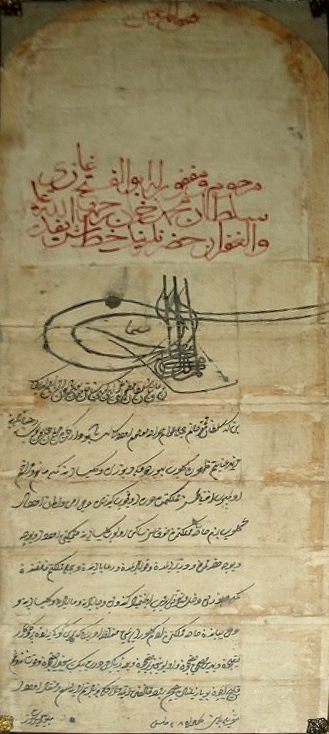|
Ahdname Of Milodraž
The Ahdname of Milodraž ( sh, Milodraška ahdnama/Милодрашка ахднама), also called the Ahdname of Fojnica (Фојничка ахднама/''Fojnička ahdnama''), was the '' ahdname'' issued on 28 May 1463 (or 1464) by the Ottoman sultan Mehmed the Conqueror to Bosnian Franciscans, represented by Anđeo Zvizdović. Tradition and history According to Bosnian Franciscan tradition, Mehmed was preparing to depart following the Ottoman conquest of Bosnia when Anđeo Zvizdović came to meet him in the Ottoman military camp in Milodraž. Led in by Mehmed's soldiers, Zvizdović drew the Sultan's attention to the exodus of Catholics from the newly conquered country. The friar specifically pointed to the necessity of maintaining the merchants, craftsmen and miners, and so succeeded in receiving Mehmed's solemn promise of religious tolerance. The Franciscans of Bosna Argentina recognized Mehmed as their sovereign, and in return he promised that "the Bosnian priests shall ... [...More Info...] [...Related Items...] OR: [Wikipedia] [Google] [Baidu] |
Mehmed II Ferman
Mehmed (modern Turkish: Mehmet) is the most common Bosnian and Turkish form of the Arabic name Muhammad ( ar, محمد) (''Muhammed'' and ''Muhammet'' are also used, though considerably less) and gains its significance from being the name of Muhammad, the prophet of Islam. Originally the intermediary vowels in the Arabic ''Muhammad'' were completed with an ''e'' in adaptation to Turkish phonotactics, which spelled Mehemed and the name lost the central ''e'' over time Final devoicing of ''d'' to ''t'' is a regular process in Turkish. The prophet himself is referred to in Turkish using the archaic version, ''Muhammed''. The name Mehmet also often appears in derived compound names. The name is also prevalent in former Ottoman territories, particularly among Balkan Muslims in Albania, Bosnia and Kosovo. The name is also commonly used in Turkish culture in the form of Mehmetçik, meaning ''little Mehmet'', for unranked soldiers. Given name Mehmed *Mehmed I (1382–1421), Ottoman ... [...More Info...] [...Related Items...] OR: [Wikipedia] [Google] [Baidu] |
Eastern Orthodox
Eastern Orthodoxy, also known as Eastern Orthodox Christianity, is one of the three main branches of Chalcedonian Christianity, alongside Catholicism and Protestantism. Like the Pentarchy of the first millennium, the mainstream (or " canonical") Eastern Orthodox Church is organised into autocephalous churches independent from each other. In the 21st century, the number of mainstream autocephalous churches is seventeen; there also exist autocephalous churches unrecognized by those mainstream ones. Autocephalous churches choose their own primate. Autocephalous churches can have jurisdiction (authority) over other churches, some of which have the status of " autonomous" which means they have more autonomy than simple eparchies. Many of these jurisdictions correspond to the territories of one or more modern states; the Patriarchate of Moscow, for example, corresponds to Russia and some of the other post-Soviet states. They can also include metropolises, bishoprics, pa ... [...More Info...] [...Related Items...] OR: [Wikipedia] [Google] [Baidu] |
1463 In The Ottoman Empire
Year 1463 ( MCDLXIII) was a common year starting on Saturday (link will display the full calendar) of the Julian calendar, the 1463rd year of the Common Era (CE) and Anno Domini (AD) designations, the 463rd year of the 2nd millennium, the 63rd year of the 15th century, and the 4th year of the 1460s decade. Events January–December * January 5 – French poet François Villon receives a reprieve from death by hanging, and is banished from Paris (his further life is undocumented). * May – The Kingdom of Bosnia falls to the Ottoman Empire. * September 15 – Battle of Vistula Lagoon: The navy of the Prussian Confederation defeats that of the Teutonic Order. * October 8 – The Truce of Hesdin ends French support for the House of Lancaster in England. Date unknown * Muhammad Rumfa starts to rule in Kano. * ''Corpus Hermeticum'' is translated into Latin, by Marsilio Ficino. * The fabled London Massacre occurs. Births * January 17 ** A ... [...More Info...] [...Related Items...] OR: [Wikipedia] [Google] [Baidu] |
Franciscans Of The Franciscan Province Of Bosnia
, image = FrancescoCoA PioM.svg , image_size = 200px , caption = A cross, Christ's arm and Saint Francis's arm, a universal symbol of the Franciscans , abbreviation = OFM , predecessor = , merged = , formation = , founder = Francis of Assisi , founding_location = , extinction = , merger = , type = Mendicant Order of Pontifical Right for men , status = , purpose = , headquarters = Via S. Maria Mediatrice 25, 00165 Rome, Italy , location = , coords = , region = , services = , membership = 12,476 members (8,512 priests) as of 2020 , language = , sec_gen = , leader_title = Motto , leader_name = ''Pax et bonum'' ''Peace and llgood'' , leader_title2 = Minister General , leader_name2 = ... [...More Info...] [...Related Items...] OR: [Wikipedia] [Google] [Baidu] |
Catholic Church In Bosnia And Herzegovina
The Catholic Church in Bosnia and Herzegovina is part of the worldwide Catholic Church under the spiritual leadership of the pope in Rome. According to the latest census from 2013, there are 544,114 Catholics in Bosnia and Herzegovina, making up 15.41% of the population. History Antiquity Christianity arrived in Bosnia and Herzegovina during the first century AD. Saint Paul wrote in his Epistle to the Romans that he brought the Gospel of Christ to Illyria. Saint Jerome, a Doctor of the Church born in Stridon (modern-day Šuica, Bosnia and Herzegovina), also wrote that St. Paul preached in Illyria. It is believed that Christianity arrived with Paul's disciples or Paul himself. After the Edict of Milan, Christianity spread rapidly. Christians and bishops from the area of present-day Bosnia and Herzegovina settled around two metropolitan seats, Salona and Sirmium. Several early Christian dioceses developed in the fourth, fifth and sixth century. Andrija, Bishop of Bi ... [...More Info...] [...Related Items...] OR: [Wikipedia] [Google] [Baidu] |
Freedom Of Religion
Freedom of religion or religious liberty is a principle that supports the freedom of an individual or community, in public or private, to manifest religion or belief in teaching, practice, worship, and observance. It also includes the freedom to change one's religion or beliefs, "the right not to profess any religion or belief", or "not to practise a religion". Freedom of religion is considered by many people and most nations to be a fundamental human right. In a country with a state religion, freedom of religion is generally considered to mean that the government permits religious practices of other sects besides the state religion, and does not persecute believers in other faiths (or those who have no faith). Freedom of belief is different. It allows the right to believe what a person, group, or religion wishes, but it does not necessarily allow the right to practice the religion or belief openly and outwardly in a public manner, a central facet of religious freedom. Fr ... [...More Info...] [...Related Items...] OR: [Wikipedia] [Google] [Baidu] |
Christianity In The Ottoman Empire
Under the Ottoman Empire's millet system, Christians and Jews were considered ''dhimmi'' (meaning "protected") under Ottoman law in exchange for loyalty to the state and payment of the jizya tax. Orthodox Christians were the largest non-Muslim group. With the rise of Imperial Russia, the Russians became a kind of protector of the Orthodox Christians in the Ottoman Empire. Conversion to Islam in the Ottoman Empire involved a combination of individual, family, communal and institutional initiatives and motives. The process was also influenced by the balance of power between the Ottomans and the neighboring Christian states. However, most Ottoman subjects in Eastern Europe remained Orthodox Christian, such as Serbs, Wallachia, Romania while present-day Albania, Bosnia and Kosovo had larger Muslim populations as a result of Ottoman influence. Civil status Ottoman religious tolerance was notable for being better than that which existed elsewhere in other great past or cont ... [...More Info...] [...Related Items...] OR: [Wikipedia] [Google] [Baidu] |
Srebrenica
Srebrenica ( sr-cyrl, Сребреница, ) is a town and municipality located in the easternmost part of Republika Srpska, an entity of Bosnia and Herzegovina. It is a small mountain town, with its main industry being salt mining and a nearby spa. As of 2013, the town has a population of 2,607 inhabitants, while the municipality has 13,409 inhabitants. During the Bosnian War in 1995, Srebrenica was the site of a massacre of more than 8,000 Bosniak men and boys, which was subsequently designated as an act of genocide by the ICTY and the International Court of Justice. History Roman era Illyrians inhabited Srebrenica and mined the silver in a nearby mine. Silver was also the main reason behind the Roman invasion of the area. During the Roman times, there was a settlement of Domavia, known to have been near a mine. Silver ore from there was moved to the mints in Salona in the southwest and Sirmium in the northeast using the Via Argentaria. The current settlement of Srebrenica ... [...More Info...] [...Related Items...] OR: [Wikipedia] [Google] [Baidu] |
Roman Catholicism In Bosnia And Herzegovina
The Catholic Church in Bosnia and Herzegovina is part of the worldwide Catholic Church under the spiritual leadership of the pope in Rome. According to the latest census from 2013, there are 544,114 Catholics in Bosnia and Herzegovina, making up 15.41% of the population. History Antiquity Christianity arrived in Bosnia and Herzegovina during the first century AD. Saint Paul wrote in his Epistle to the Romans that he brought the Gospel of Christ to Illyria. Saint Jerome, a Doctor of the Church born in Stridon (modern-day Šuica, Bosnia and Herzegovina), also wrote that St. Paul preached in Illyria. It is believed that Christianity arrived with Paul's disciples or Paul himself. After the Edict of Milan, Christianity spread rapidly. Christians and bishops from the area of present-day Bosnia and Herzegovina settled around two metropolitan seats, Salona and Sirmium. Several early Christian dioceses developed in the fourth, fifth and sixth century. Andrija, Bishop of Bistue (), ... [...More Info...] [...Related Items...] OR: [Wikipedia] [Google] [Baidu] |
Firman
A firman ( fa, , translit=farmân; ), at the constitutional level, was a royal mandate or decree issued by a sovereign in an Islamic state. During various periods they were collected and applied as traditional bodies of law. The word firman comes from Persian meaning "decree" or "order". On a more practical level, a firman was, and may still be, any written permission granted by the appropriate Islamic official at any level of government. Westerners are perhaps most familiar with the permission to travel in a country, which typically could be purchased beforehand, or the permission to conduct scholarly investigation in the country, such as archaeological excavation. Firmans may or may not be combined with various sorts of passports. Etymology Farmān (also spelled firman) is the modern Persian form of the word and derives from Middle Persian (Pahlavi) ''framān'', ultimately from Old Persian ''framānā'' (''fra'' = "fore", Greek πρό). The difference between the modern P ... [...More Info...] [...Related Items...] OR: [Wikipedia] [Google] [Baidu] |
Habsburg Monarchy
The Habsburg monarchy (german: Habsburgermonarchie, ), also known as the Danubian monarchy (german: Donaumonarchie, ), or Habsburg Empire (german: Habsburgerreich, ), was the collection of empires, kingdoms, duchies, counties and other polities that were ruled by the House of Habsburg, especially the dynasty's Austrian branch. The history of the Habsburg monarchy can be traced back to the election of Rudolf I as King of Germany in 1273 and his acquisition of the Duchy of Austria for the Habsburg in 1282. In 1482, Maximilian I acquired the Netherlands through marriage. Both realms passed to his grandson and successor, Charles V, who also inherited the Spanish throne and its colonial possessions, and thus came to rule the Habsburg empire at its greatest territorial extent. The abdication of Charles V in 1556 led to a division within the dynasty between his son Philip II of Spain and his brother Ferdinand I, who had served as his lieutenant and the elected king of Hungary a ... [...More Info...] [...Related Items...] OR: [Wikipedia] [Google] [Baidu] |







